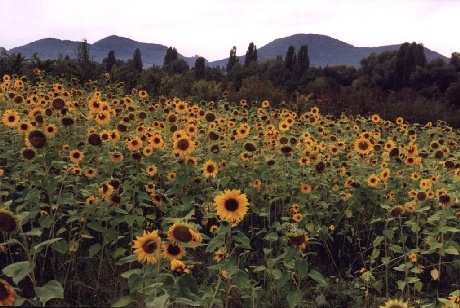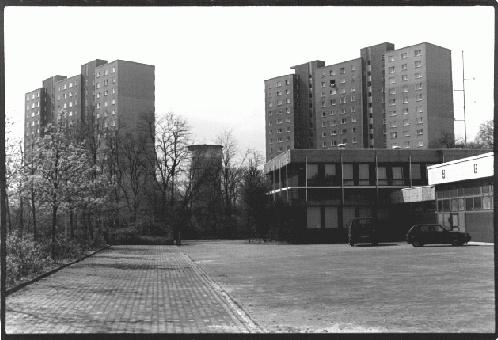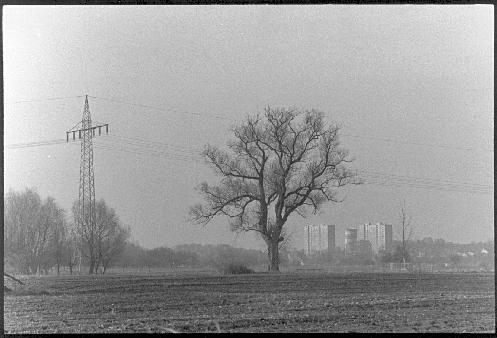

"Die Palz", which is the regional dialect's version of "die Pfalz" (engl: the Palatinate), is a bright and sunny landscape with wide planes as well as hills and medium-sized mountains in the south of the Bundesland (engl: state) Rheinland-Pfalz of the Federal Republic of Germany. Its eastern border is constituted by the river Rhine (though some might insist that the towns of Mannheim and Heidelberg beyond that line belong to "die Palz" as well), while in the west it borders with the Bundesland Saarland. Towards the south it is adjacent to the Alsace of France.
On average, it is the warmest part in the whole country (the "Tuscany of Germany"), a feature already well spotted by the ancient Romans nearly 2000 years ago. It was for this reason that they felt inspired to bring over the wine from their mediterranean homelands and start growing it directly on location in this remote part of their Empire. Unlike the Romans, the wine nowadays continues to play a dominant role in the industrial and, especially, social life of the region, and beyond. The heartland of the wine growing parts of "die Palz" is the "Deutsche Weinstraße" -- the German Wine Route -- which extends from Bockenheim in the north all the way down to Schweigen in the south over about 80km.

Connaisseurs of international FOOTBALL (what the f*** is "soccer" ???) will associate "die Palz" with the German Football Champions of, e.g., 1991 and 1998 1. FC Kaiserslautern, the "FCK", in the first place, as, in fact, do most of the local residents ("die Pälzer") anyway. It is the pride of the people and the club of the 1954 World Cup hero Fritz Walter. People more interested in international politics, on the other hand, may instead recognise it as the region the record-long running former German Chancellor, Dr. Helmut Kohl, originates from. Well, talking about individual people's roots, let's just mention for the moment that apparently the ancestors of both the ketchup mogul H.P. Heinz as well as Elvis Presley were "Pälzer" themselves, the latter being the descendant of an eighteenth century family from Hochstadt known by the name of "Pressler". In this context, it has to be said that "die Palz", historically being an economically less developed area, has a long record of people moving to shores abroad; in a certain sense a tradition maintained right into the present age.
From the point of view of the outdoor enthusiast, two aspects immediately spring to one's mind in connection with "die Palz". First, the mountainous part, which is covered by the largest connected piece of forest in Germany and which is known as "der Pfälzerwald", offers a vast variety of opportunities for walks of all different sorts throughout the whole year. Most popular as destinations for tours are the many remnants of destroyed castles from the Middle Ages all around, as they often provide the sites for spectacular panoramic views. A goodie in the latter respect is found from the small tower on top of the "Rehberg" mountain near Annweiler. Second, the planes subtended by the Pfälzerwald and the river Rhine boast a large number of lakes of up to 400m in diameter -- the "Baggerseen" --, which, on hot days from May till September, invite one to get all-body refreshment and enjoy sunny beaches.
Both activities can be perfectly supported by visiting, thereafter, one of the uncountable wine festivals which are hosted all across the region. The wine festival season properly gets underway at around mid-June and lasts until well into November. It is suggested to try and taste what can be called the "drink of the region" -- the "Schoppe Riesling Schorle" -- on those occasions. "Schoppe", dialect for "Schoppen", states the volume -- 1/2 litre --, "Riesling" is the name of the particular kind of grape from which this white wine is gained, and "Schorle" specifies that the drink is a mixture of 2/3 of the wine filled up with 1/3 of sparkling mineral water. Foodwise the so-called "Saumaache", dialect for "Saumagen", is recommended, which also Dr. Kohl frequently calls his favourite dish in public. This is the skin of a pig's stomach, filled with a spicy mixture of chopped pork, ham, diced potatoes, onions, garlic, dried roles and eggs, all stirred together, which is cooked for a couple of hours and then served in thumb-thick slices, together with fresh dark farmhouse bread and Sauerkraut. Be assured, it tastes much better than the lay person's fantasy will ever be able to imagine.
Well, eventually you will have to go and find out for yourself what "die Palz" is all about. As a potential guide, here's a list of "Palz" online information and related links:
(Any comments or suggestions may be forwarded to me directly at henk@gmunu.mth.uct.ac.za).

 Home
Home
Created: Sun, 6-4-1997
Last revision: Thu, 27-7-2000 (This page is under construction)